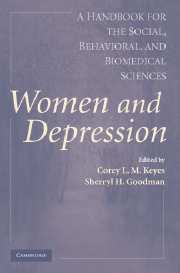Book contents
- Frontmatter
- Contents
- List of Contributors
- Foreword
- Preface
- PART I NOSOLOGY, MEASUREMENT, AND THE EPIDEMIOLOGY OF WOMEN AND DEPRESSION
- PART II BIOLOGICAL, DEVELOPMENTAL, AND AGING MODELS OF RISK
- PART III COGNITIVE, EMOTIONAL, AND INTERPERSONAL MODELS OF RISK
- PART IV SOCIAL, POLITICAL, AND ECONOMIC MODELS OF RISK
- 12 Social Suffering, Gender, and Women's Depression
- 13 Women, Work, and Depression
- 14 Culture, Race/Ethnicity, and Depression
- 15 Trauma and Depression
- 16 Public Health Approach to Depression and Women
- PART V SYSTEMS AND PROCESSES OF TREATMENT, PREVENTION, AND POLICY
- Author Index
- Subject Index
- References
13 - Women, Work, and Depression
Conceptual and Policy Issues
Published online by Cambridge University Press: 05 June 2012
- Frontmatter
- Contents
- List of Contributors
- Foreword
- Preface
- PART I NOSOLOGY, MEASUREMENT, AND THE EPIDEMIOLOGY OF WOMEN AND DEPRESSION
- PART II BIOLOGICAL, DEVELOPMENTAL, AND AGING MODELS OF RISK
- PART III COGNITIVE, EMOTIONAL, AND INTERPERSONAL MODELS OF RISK
- PART IV SOCIAL, POLITICAL, AND ECONOMIC MODELS OF RISK
- 12 Social Suffering, Gender, and Women's Depression
- 13 Women, Work, and Depression
- 14 Culture, Race/Ethnicity, and Depression
- 15 Trauma and Depression
- 16 Public Health Approach to Depression and Women
- PART V SYSTEMS AND PROCESSES OF TREATMENT, PREVENTION, AND POLICY
- Author Index
- Subject Index
- References
Summary
Social scientists have been concerned about the relationship between work and mental health among women for several decades. Since the 1960s, there have been large-scale changes in women's employment, social roles, social theory, and social policy, all of which have shaped the scholarly literature. This chapter summarizes this literature and its evolution in the context of the social changes that have shaped the study of women, work, and depression. It gives a broad overview of the literature, with particular focus on research questions and debates that have emerged in the past decade. Implications for future research and social policy are highlighted, as well.
EARLY RESEARCH ON WOMEN, WORK, AND DEPRESSION
Social science research on employment and women's well-being reached its peak in the 1980s and 1990s (see Klumb & Lampert, 2004, for a review). As the number of women in the labor force increased, researchers became concerned about the impact of employment on women's psychological well-being. A number of studies had found that employed wives exhibited fewer symptoms of psychological distress and depressive symptomatology than did nonemployed wives (e.g., Pearlin, 1975; Radloff, 1975; Rosenfield, 1980). Explanations for this finding generally focused on the importance of the prevailing female sex role of housewife and mother. It was argued that tasks involved in women's traditional domestic roles were unskilled, repetitive, and isolating and thus apt to be psychologically distressing (Gove & Tudor, 1973).
- Type
- Chapter
- Information
- Women and DepressionA Handbook for the Social, Behavioral, and Biomedical Sciences, pp. 309 - 327Publisher: Cambridge University PressPrint publication year: 2006
References
- 2
- Cited by

